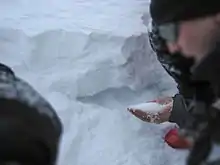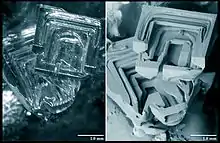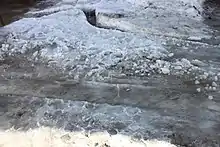Depth hoar
Depth hoar, also called sugar snow[1] or temperature gradient snow (or TG snow),[2] are large snow-crystals occurring at the base of a snowpack that form when uprising water vapor deposits, or desublimates, onto existing snow crystals. Depth hoar crystals are large, sparkly grains with facets that can be cup-shaped and that are up to 10 mm in diameter. Depth hoar crystals bond poorly to each other, increasing the risk for avalanches.

"Sugar snow" as a layer in a snowpack

Depth hoar crystals, imaged with light and with scanning electron microscopy

Sugar snow - panoramio
The formation of depth hoar in Arctic or Antarctic firn can cause isotopic changes in the accumulating ice. This can influence analysis of ice cores in scientific research.
References
- "Be Aware of Depth Hoar". Powder Magazine. Retrieved April 15, 2014.
- "Depth Hoar". Avalanche.org. American Avalanche Association. Retrieved 6 March 2019.
- Pfeffer, W. T.; Mrugala, R. (2002). "Temperature gradient and initial snow density as controlling factors in the formation and structure of hard depth hoar". Journal of Glaciology. 48 (163): 485–494. doi:10.3189/S0022143000002008.
External links
- The Avalanche Encyclopedia, extensive summary with animation of formation process
Further reading
This article is issued from Wikipedia. The text is licensed under Creative Commons - Attribution - Sharealike. Additional terms may apply for the media files.